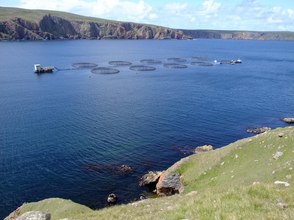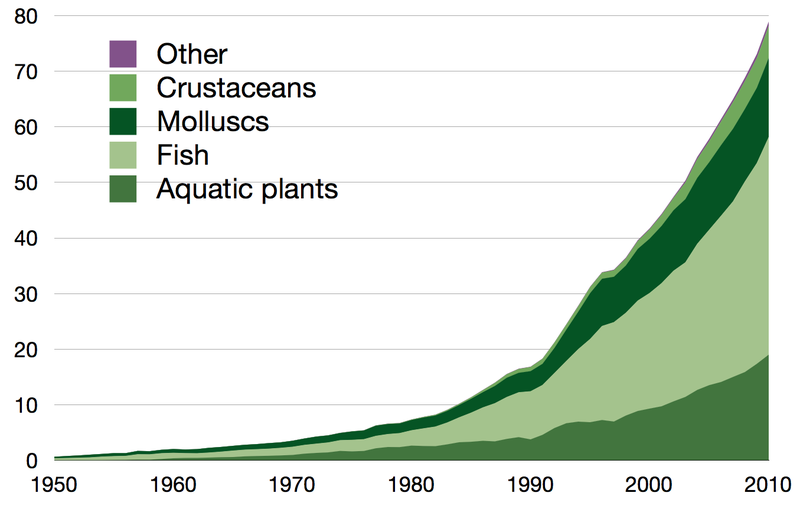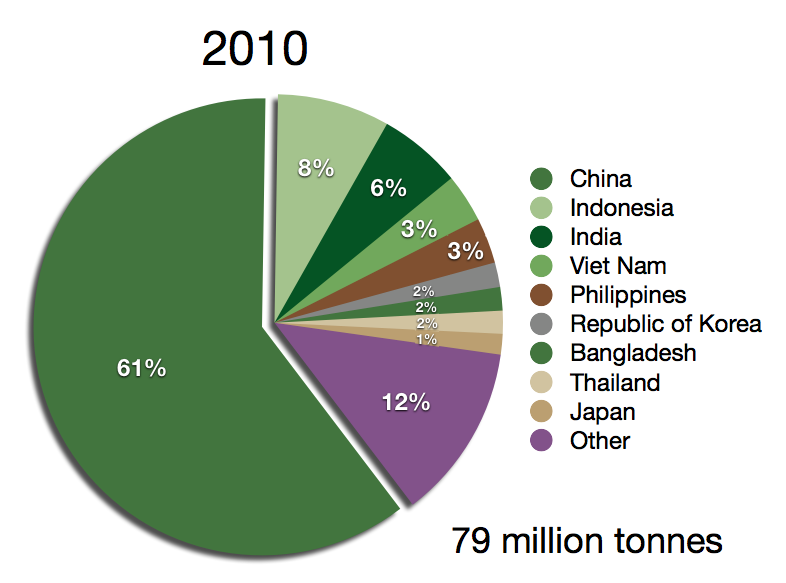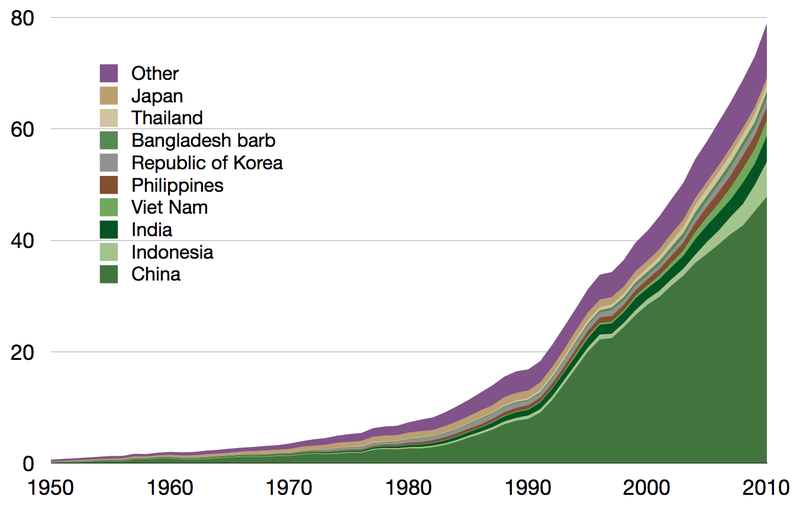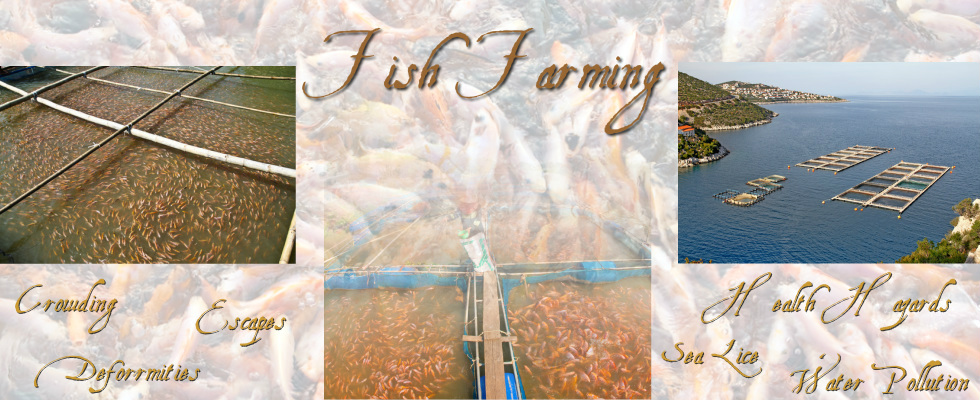
Fish Farming
Fish farming is the main form of aquaculture
involving raising fish commercially in tanks or enclosures for food. Aquaculture is
currently the world's fastest growing food production sector, growing at
nearly 10% a year, which is
3 times faster than land-based animal agriculture, with
upwards of 50% of all seafood consumed worldwide being farmed. When farmed properly,
fish farming can help relieve pressure off wild fisheries and provide income to coastal communities, however, as production rises, so does aquaculture's impacts on the environment and wild marine species. One of the greatest concerns to marine scientists and advocates of the ocean is the enormous waste involved in using wild fish to feed farmed fish. It can take
more than 5 pounds of fish from the ocean to produce just 1 pound of farmed salmon or sea bass
you see sitting in your grocery store seafood section. The methods used on most fish farms are
not sustainable and put enormous pressure on the surrounding environment and wildlife. The largest growth area for fish farming is species like
salmon, shrimp and cod, which are
fed fishmeal and fish oil from wild-caught small fish, which means we must continue taking vast amounts of wild small fry from the sea that repopulating wild stocks with farmed fish will never be possible. According to
WWF, "The amount of feed needed for farmed fish and shrimp is staggering. For example: up to 22kg of wild-caught fish is needed to produce just 1kg of farmed tuna, 4kg of wild-caught fish is needed to produce 1kg of farmed salmon, up to 2kg of wild-caught fish is needed to produce 1kg of farmed marine shrimp. This means that the aquaculture industry is using a large proportion of the fish caught in the world’s oceans each year." Taking up to five times as much wild fish to feed farmed fish is depriving whales, dolphins, birds and other fish of a key part of their diet and has devastating effects on coastal communities by depriving them of a much needed food source, which is especially true in
developing countries, where the fish are farmed mainly for export.
Learn more.
"Many fish-lovers would be horrified to learn that huge quantities of fish and shrimp are now being grown in giant nets, cages, and ponds where antibiotics, hormones and pesticides mingle with disease and waste. These industrialized aquaculture facilities are rapidly replacing natural methods of fishing that have been used to catch fresh, wild seafood for millennia." ~ Food and Water Watch
Fish farm in Ronas Voe
for
HU2882. Salmon are farmed here. The small boat in the HU2783 geograph can be seen at the far right of the photograph. © Copyright
Tim Harrison
and licensed for reuse under this
Creative Commons License. Click to enlarge.
Conditions in fish farms are so horrid that as many as 40% of farmed fish die
before they are sent for slaughter.
| Global Aquaculture Production
Global aquaculture production by species groups in million tons, 1950–2010, as reported by the FAO. Based on data sourced from the
FishStat database.
Wikipedia Commons
| Click to enlarge
|
Aquaculture Production by Country
Global aquaculture production by country in million tonnes, 1950–2010, as reported by the FAO. Based on data sourced from the
FishStat database.
Wikipedia Commons
|
Click to enlarge
|
Aquaculture Production by Country
Global aquaculture production by country in million tonnes, 1950–2010, as reported by the FAO. Based on data sourced from the
FishStat database.
Wikipedia Commons
| Click to enlarge
|
A single fish farm with 200,000 fish can produce as much daily sewage as a city of 65,000 people, all in one location. Learn more.
"Offshore aquaculture will not significantly increase the supply of quality seafood to U.S. consumers, and products will certainly not make their way to developing countries. Further, using wild fish to feed farmed fish is an unsustainable practice that depletes forage fish populations, threatens the food security of many people in developing countries, and takes a valuable food source away from people who need it." ~ Food and Water Watch
Crowding
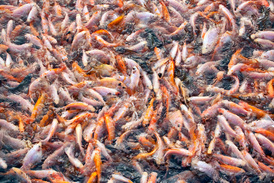
Fish Farming photo via Shutterstock | Click to enlarge
The average salmon farm is comprised of a network of submerged net pens made of metal or plastic holding, on average,
about 50,000 salmon each. These "underwater chicken farms" provide a
typical 2 1/2 foot salmon an area of water the size of a bathtub their entire lives. Trout farms are even worse, with
as many as 27 full-grown fish in a bathtub-sized space. Such an immense amount of fish tightly squeezed in one space causes the fish to suffer serious stress, which in turn makes them
more susceptible to disease
and creates an
unimaginable amount of feces that settles on the seafloor, sinking into the sediment, smothering bottom-dwelling organisms
and
de-oxygenating the water causing toxic algal blooms. These fish are naturally built to swim immense distances, which leads them to
thrash against one another and to the sides of the pen opening sores and wounds, which are prone to parasitization, infection and disease. The crowding and filthy environment can also lead to
high incidences of severe cataracts, often so bad that they cause the eyes to bleed and the fish to go blind, and cause deformities in their backs, making them look more like carp rather than the sleek, elegant shape of a healthy salmon.
Learn more.
Compassion in World Farming: In Too Deep - Why Fish Farming Needs Urgent Welfare Reform
"The high levels of antibiotics and pesticides used to control diseases in farmed fish have a polluting effect on surrounding habitats, while the diseases themselves often spread to wild populations and reduce the effectiveness of the same drugs for human diseases. Excess food and untreated wastes from farms also find their way into the wider environment, raising nutrient levels and causing algal blooms which can de-oxygenate large areas of ocean, cloud coastal waters and alter seafloor ecosystems." ~ Ted Danson, Oceana
Escapes, Genetic Pollution and Deformities
Farmed fish escapes are inevitable. Whether the open net pens are damaged by natural disasters, such as storms and earthquakes, or by predators, such as sea lions and sharks, the intentional or unintentional release of fish raised in aquaculture production occurs every year, with
upwards of 10 million Chilean farmed salmon reportedly escaping each year. The escape of millions of salmon and other fish from enormous net pens every year has seriously
harmed wild fish populations and altered the marine ecosystem, coastal rivers and even the entire oceanic food chain
by eating large amounts of prey fish, such as insects and crustaceans, that other predators in the area normally would have eaten. Even during normal operations, fish in open net pens
escape in small numbers, which results in
interbreeding and competition with wild salmon and other wild fish for food, habitat, and mates. Wild fish survive because they are naturally resistant to disease and are superb at hunting and avoiding predators.
Farmed fish drastically lose these characteristics within a few generations. Way too often,
farmed fish escape their pens
and breed with wildfish passing on their "bad genes" to their offspring
leading to significant population increases of "frankenfish," which
could lead to the extinction of both wild and genetically engineered fish in that region. Escaped salmon have also been linked to the
spread of infectious diseases and sea lice to wild populations. According to the
Pure Salmon Campaign, "Escaped fish transmit diseases and parasites to wild salmon, and threaten to establish viable colonies that could not only push wild salmon to extinction, but also related species such as steelhead salmon and sea trout." According to
Oceana, "Atlantic
salmon
escapes on the U.S. and Canadian west coasts are common; there were 350,000 known escapes in 1997 and farmed Atlantic salmon have been found thousands of miles away from the closest salmon aquaculture facilities. Escapes are a significant concern because they occur on a regular basis. Escaped fish have been known to travel great distances and they are a threat to the long-term health and fitness of native populations." This results in serious environmental, economic and social costs that future generations will be largely left to deal with.
Learn more.
"Genetic experimentation to speed up the growth process and boost production of farmed salmon has increased. Transgenic salmon, those whose DNA has been altered by inserting genes from other species, have been developed that reach market weight in half the time it takes a regular salmon, which is 18 months compared to 36 months. If these frankenfish escape their pens, they could not only outcompete their wild, natural cousins, but also interbreed with them, damaging the gene pool and causing physical deformities in the wild population. The future of aquaculture will be charted in the years to come. A greener and bluer future is possible, but we must avoid the mistakes made by industrial livestock production-“factory farming”-which have led to environmental degradation, species loss and public health risks and pursue clean, locally based sustainable aquaculture." ~ Ted Danson, Oceana
Sea Lice
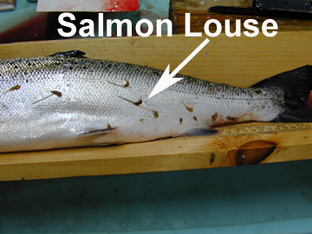
Image Credit: NOAA | Click for source
Infection, disease, blindness and death are common in fish farms, but by far the most common and destructive condition is infestation by sea lice. According to
Farmed and Dangerous, "Sea lice are small marine parasites that occur naturally on many different species of wild fish including wild adult salmon. Sea lice are planktonic and are transported on the tide. When they encounter marine fish they attach themselves, usually on the skin, fins and/or gills and feed off the mucous or skin." The contaminants from sea-based aquafarms, such as
uneaten chemical-laden food, fish excrement and swarms of parasites make their way to surrounding waters spreading the infectious diseases inside the cages to other fish in the area, increasing the occurrence of sea lice by up to a thousandfold. Normally,
wild salmon would migrate between fresh and salt water, which keeps the salt-water sea lice at bay, however, farmed salmon spend their entire lives in coastal areas, which drastically increases their chance of getting parasites. Once infested, there is nowhere to run or hide inside the nets. Feeding on the skin and flesh of salmon,
causing their scales to fall off and leaving behind large sores, these parasitic attacks can eat all the way to the bone, especially when the fish have nowhere to run in the confines of a fish farm net where hundreds can attach to a single fish. According to
WWF, "More fish farms mean more hosts for parasites - indeed, in some parts of Northern Europe, sea lice numbers are now significantly higher as a result of the millions of farmed fish in the sea." Peer-reviewed research has shown that
1-3 sea lice are enough to kill a juvenile pink salmon
and
10-15 can kill a fish.
Learn more.
Water Pollution
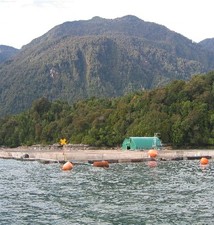
Aquaculture installations in Southern Chile.
There are many aquaculture facilities that are closed and pose no threat of water pollution, however, according to
WWF, "Open net cage fish farms and land-based fish farms can discharge significant amounts of wastewater containing nutrients, chemicals, and pharmaceuticals that impact on the surrounding environment." These aquafarm wastewater contaminants includes
fish excrement, uneaten chemical-laden food, and swarms of parasites, which spread pollution and disease to ocean fish in the area and surrounding ocean. The water flowing out of an aquaculture facility can carry with it
excessive particulates, bacteria, diseased organisms and polluting chemicals harming surrounding habitats, causing algal blooms, poisoning ocean wildlife and other severe disturbances. Furthermore,
feed and fecal matter from these facilities can deplete the dissolved oxygen concentrations around and certainly within the facilities. Even the
anti-fouling agents to keep the cages and pens clean are highly toxic. According to
Farmed and Dangerous, "In open net-cage farming, the use of mesh nets means there is no way to prevent waste feed, which can be laced with
antibiotics
or
pesticides, and fish feces from passing directly into the ocean. The waste from all of these fish can build up under the pens smothering portions of the ocean bottom, contaminating the marine ecosystem and depriving species of oxygen. The
contaminants
from salmon farms have also been linked to elevated levels of mercury in rockfish and parasites, tumors and lesions on ground fish harvested near salmon farms, impacting a
traditional food source
still used by coastal communities."
Learn more.
Health Hazards of Eating Farm-Raised Fish
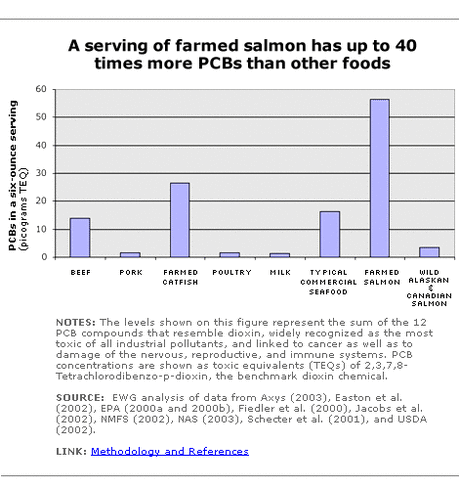
Chart Courtesy of the Environmental Working Group | Click for source and to learn more
Aquaculture is
currently the world's fastest growing food production sector, growing at
nearly 10% a year, which is
3 times faster than land-based animal agriculture, with
upwards of 50% of all seafood consumed worldwide being farmed. With half of our fish being farmed, consumers should know if farmed fish offers the same health benefits as wild fish and whether or not there are chemicals being used in fish farming that raise health concerns. Due to high concentrations of fish feed, compared to wild fish,
farm-raised fish contain higher levels of chemical pollutants, such as PCBs, which are known carcinogens, and according to a 2004 Global Assessment of Organic Contaminants in Farmed Salmon, there were
13 persistent organic pollutants found in farmed salmon, with each chemical measuring 10 times greater in farmed salmon than in their wild counterparts. Moreover, the large volumes of antibiotics used to treat diseases and parasites from the fully exposed and helpless fish directly affect consumers by
developing super strains of bacteria that are resistant to antibiotics, which makes diseases less treatable, and locks in a cycle of steadily increasing antibiotic use. According to
Farmed and Dangerous, "A 2005 study published in the Journal of Nutrition compared the health benefits of farmed salmon to health risks. The study found that consumers, especially young children and women of child-bearing age, concerned about health impairments—such as reduction in IQ and other cognitive and behavioral effects—can minimize their exposure to cancer causing contaminants by choosing wild salmon or by selecting other sources of omega fatty acids. A 2004 study in Science showed that concentrations of contaminants are significantly higher in farmed salmon than in wild, and that eating farmed Atlantic salmon may pose health risks that detract from the positive effects of fish consumption." The U.S. EPA advises that consumers in
North America eat 1 serving of farmed salmon ever 2.5 months, in South America - 1 serving every month, and in Europe - 1 serving every five months. The health risks of farmed salmon are especially prevalent among young children and women of child-bearing age. According to a
2010 CTV News Investigation, wild salmon are more nutritious than farmed salmon with 8 times more Vitamin D and 3 times more Vitamin A per 100 gram serving and that although farmed salmon can have more omega-3s due to their artificially increased fat, they can also “accumulate higher levels of toxins such as PCBs, a banned toxin found in materials like asbestos."
Wild salmon is a less contaminated source of omega-3 than farmed salmon.
Learn more.
- Further Resources -
"Seven of ten farmed salmon purchased at grocery stores in Washington DC, San Francisco, and Portland, Oregon were contaminated with polychlorinated biphenyls (PCBs) at levels that raise health concerns, according to independent laboratory tests commissioned by Environmental Working Group. These first-ever tests of farmed salmon from U.S. grocery stores show that farmed salmon are likely the most PCB-contaminated protein source in the U.S. food supply." ~ Environmental Working Group

